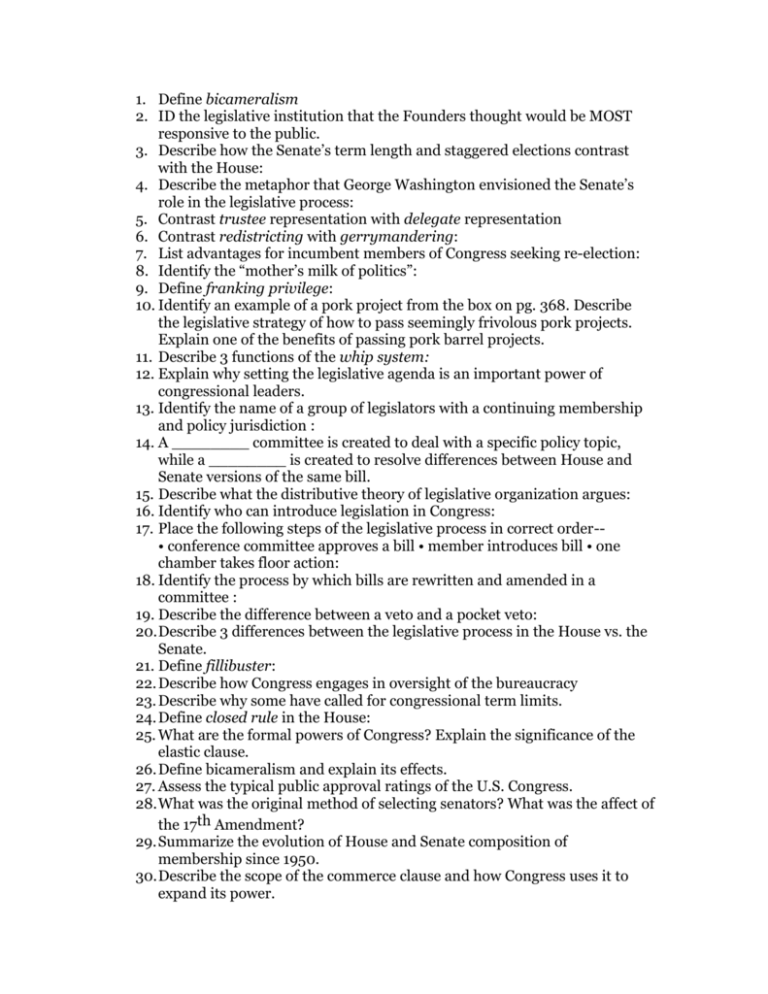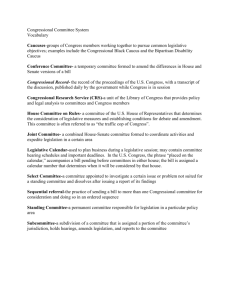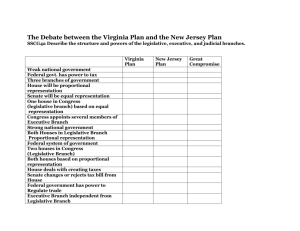Article I PreQuestions
advertisement

1. Define bicameralism 2. ID the legislative institution that the Founders thought would be MOST responsive to the public. 3. Describe how the Senate’s term length and staggered elections contrast with the House: 4. Describe the metaphor that George Washington envisioned the Senate’s role in the legislative process: 5. Contrast trustee representation with delegate representation 6. Contrast redistricting with gerrymandering: 7. List advantages for incumbent members of Congress seeking re-election: 8. Identify the “mother’s milk of politics”: 9. Define franking privilege: 10. Identify an example of a pork project from the box on pg. 368. Describe the legislative strategy of how to pass seemingly frivolous pork projects. Explain one of the benefits of passing pork barrel projects. 11. Describe 3 functions of the whip system: 12. Explain why setting the legislative agenda is an important power of congressional leaders. 13. Identify the name of a group of legislators with a continuing membership and policy jurisdiction : 14. A ________ committee is created to deal with a specific policy topic, while a ________ is created to resolve differences between House and Senate versions of the same bill. 15. Describe what the distributive theory of legislative organization argues: 16. Identify who can introduce legislation in Congress: 17. Place the following steps of the legislative process in correct order-• conference committee approves a bill • member introduces bill • one chamber takes floor action: 18. Identify the process by which bills are rewritten and amended in a committee : 19. Describe the difference between a veto and a pocket veto: 20. Describe 3 differences between the legislative process in the House vs. the Senate. 21. Define fillibuster: 22. Describe how Congress engages in oversight of the bureaucracy 23. Describe why some have called for congressional term limits. 24. Define closed rule in the House: 25. What are the formal powers of Congress? Explain the significance of the elastic clause. 26. Define bicameralism and explain its effects. 27. Assess the typical public approval ratings of the U.S. Congress. 28. What was the original method of selecting senators? What was the affect of the 17th Amendment? 29. Summarize the evolution of House and Senate composition of membership since 1950. 30. Describe the scope of the commerce clause and how Congress uses it to expand its power. 31. Define the franking privilege and relate it to incumbency advantage. 32. Define both marginal districts and safe seats. 33. Define sophomore surge. 34. Explain the process of reapportionment and redistricting. 35. Define both gerrymandering and malapportionment. 36. Explain how the distributive theory affects the work of Congress. 37. Explain the Congressional voting styles of trustee, delegate, partisan, and politico. 38. Assess the leadership positions in both the House and Senate. Analyze the power of each. 39. Describe the purpose of the Congressional Black Caucus and other specialized caucuses. 40. Define the difference between standing committees and conference committees. 41. Explain incumbency advantages. 42. Define entitlement spending, mandatory spending, and discretionary spending. 43. Explain the significance of single member districts. 44. Summarize the bill making process. 45. Describe the power and duties of the House Rules Committee. 46. Explain the importance of congressional committees to the legislative process. 47. Define filibuster. Define cloture. 48. Explain why all revenue bills originate in the House Ways and Means Committee. 49. Define a mark up session. 50. What is a discharge petition? How often are they used? Explain. 51. Identify and state the significance of pork barrel spending and earmarks. 52. What is the difference between a Congressional authorization and appropriation? 53. Name the presidential appointments that require the advice and consent of the Senate. 54. Other than lawmaking, explain the duties of Congress. How does Congress use its oversight powers?






